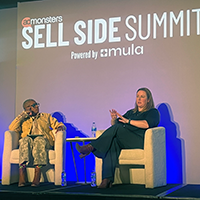FOR MANY, waiting through the early stages of determining lifetime customer value feels like eating Brussels sprouts. It’s not something you do for fun, but in anticipation of benefits to come later-like a really good dessert or increased profits.
For cataloger DM Management Co. Inc., Hingham, MA, it’s later now. A strategy incorporating a view of customers beyond a given mailing is paying off handsomely.
In 1996 the company (whose stockholders will vote on a proposed name change, to The J. Jill Group, later this month) shook up its operations. The unprofitable Caroll Reed concept was discontinued, while another title, The Very Thing, was folded into Nicole Summers, a mature woman’s book. J. Jill, a flagship catalog, was refashioned with a greater emphasis on casual-style natural fiber clothes.
Audience cannibalization played a role in the need to restructure. It had not been uncommon for the same customer to receive all four catalogs at the same time, in the same polybag. The strategy took advantage of postage efficiencies, but likely cut into orders received.
DM Management also began looking at its customers less in terms of results from any one mailing and more in terms of overall profitability. The company, with help from database service provider Centrobe, Louisville, CO, now determines the number of catalogs sent to a particular individual based on lifetime spending patterns.
“Instead of optimizing one mailing, we want to optimize the profitability of several,” says DM Management’s director of marketing analysis Chris Fawcett. “If over the last 12 months we mailed out 14 catalogs and [a customer] responded three times, we have a feel for the profitability of the name over time.”
The goal is to maintain sales levels while reducing circulation. A customer receiving three mailings, and ordering from the first and third, allows DM Management to determine whether the second mailing can be eliminated, either for that woman or the entire customer segment she falls into.
“The objective is to see if [a cataloger] is not significantly decreasing profitability by not sending a book,” says Centrobe’s general manager for database marketing services Mark Labovitz.
Most models done by looking at the customer during one static period allow a marketer to identify the customers that are clear winners and losers. “But money is made in the middle. The issue becomes how do we maximize what’s there” in the gray areas, says Labovitz.
Sometimes, the answer is cross-selling as well as mailing management. The primary method of determining which customer gets cross-mailed, according to Fawcett, is a combination of base-level modeling done by Centrobe, augmented by Abacus catalog database information and recency and frequency data. Cannibalization is no longer a significant concern. “A woman who buys a business suit from Nicole Summers may buy weekend or casual Friday clothes from J. Jill,” says Fawcett.Currently, the J. Jill file holds 1.9 million customer names, and Nicole Summers contains some 900,000. About 300,000 are considered buyers from both catalogs.
The processes have had dramatic results: J. Jill increased circulation 101.5% during fiscal 1998 and net sales jumped 123.7%. Net sales for Nicole Summers actually declined 12.9% in fiscal 1998, but given that the catalog’s circulation dropped 17.8% over the same time, this was due to weeding out unprofitable buyers.
The company’s total sales bear this out. Revenue in 1998 was up 61% to nearly $219 million-$83 million more than in 1997. At the same time, the company’s total catalog circulation rose by only 46%, from 50.5 million to just under 74 million. This retargeted base was more profitable as well: Net income as a percentage of net sales was up almost a full percentage point during the year, from 2.9% to 3.8%.



